

Putting Technology in Its Place. Kentaro Toyama calls himself “a recovering technoholic”—someone who once was “addicted to a technological way of solving problems.”
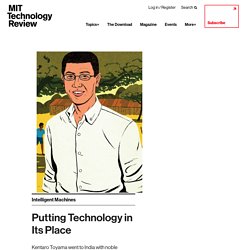
Five years in India changed him. After getting his PhD in computer science and working on machine vision technologies at Microsoft, Toyama moved to Bangalore in 2004 to help lead the company’s new research center there. He and his colleagues launched dozens of projects that sought to use computers and Internet connectivity to improve education and reduce poverty. But early successes in pilot projects often couldn’t be replicated; in some schools, computers made things worse. In a book being released this spring, Geek Heresy: Rescuing Social Change from the Cult of Technology, Toyama argues that technologists undermine efforts at social progress by promoting “packaged interventions” at the expense of more difficult reforms.
When you went to India, technological optimism was flourishing there. Yes, absolutely. What was your success rate? Arviointi korkeakouluopetuksessa anu_ylitalo_tritonia_edulab_2011. E-Portfolio. Mikä sovellus paras mihinkin tehtävään? — IT-palvelut. Julkaisufoorumi. Luento etä-läsnä, vuorovaikutteinen luento ja pienryhmätyöskentely – Ajatus liikkuu - iloa oppimiseen! Tavoite: Mahdollistaa oppimisen ja työskentelyn luokkatilassa olevan opiskelijaryhmän ja yhden etäopiskelijan tai etänä olevan ryhmän välillä.
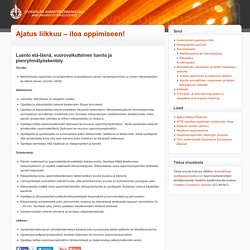
Valmistelut: Varmista, että tilassa on langaton verkko.Opettaja ja etäopiskelija jakavat keskenään Skype-tunnukset.Opettaja ja etäopiskelija käyvät etukäteen Skypellä keskustelun lähiopiskelupäivän toimintatavoista, opintojakson tavoitteista, sisällöistä yms. Sovitaan etäopiskelijan osallistumisen aikatauluista, miten päivän työskentely rytmittyy ja milloin etäopiskelija on mukana.Opettaja laittaa opetusmateriaalit Optimaan tai muuhun oppimisympäristöön. Bibliometriikan kaikkein lyhin oppimäärä kirjastolaisille. Julkaisuja ja niihin viittaamisia analysoimalla tulee esiin mielenkiintoisia asioita.
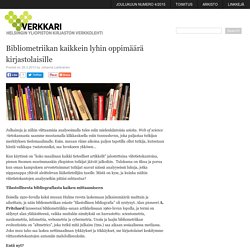
HTK ohje 2012. Article. The Ultimate Guide To Note Taking In Class [Infographic] Many studious types will swear that they can take everything in from their lecture or seminar just by listening and engaging, but research suggests that can’t be true.
![The Ultimate Guide To Note Taking In Class [Infographic]](http://cdn.pearltrees.com/s/pic/th/ultimate-taking-infographic-104249580)
Approximately 60% of information can be forgotten after only 9 hours. If you don’t want to start your assignment or exam with only 40% of the knowledge you could have, you should probably make a change. Sure, revising in your student accommodation post-lecture can help, or you could let this infographic show you why note taking is so important, and the best methods for doing so, depending on what kind of person you are. Here’s The Ultimate Guide To Note Taking In Class. Remember, don’t just read it, take note. Full transcript and options to embed this infographic can be found at the bottom of this page. Infographic transcript Ultimate guide to note taking in class Effective note taking in class is essential.
The forgetting curve What happens if you don’t organise and review lecture notes. Writing in the Sciences - Stanford University. About the Course This course trains scientists to become more effective, efficient, and confident writers.

This is a hands-on course that emphasizes interactive examples and practice. In the first four weeks, we will review principles of effective writing, examples of good and bad writing, and tips for making the writing process easier. In the second four weeks, we will examine issues specific to scientific writing, including: authorship, peer review, the format of an original manuscript, and communicating science for lay audiences. MOOCs: the Next Evolution in E-Learning for Businesses? Robert Hall doesn’t consider himself an expert on massive open online courses, otherwise known as MOOCs.

But after creating learning content through MOOC vendor Udemy, Hall is the go-to guy at Marek Bros., a Houston-based construction company. Hall, a project manager by trade, used Udemy’s open-source software to develop instructional videos about new processes for managing construction-related bidding data. Frustrated by the inefficient way data were managed, Hall took it upon himself to find a better way.
Yliopistopedagogiikka. Bellwether Education Partners. Massive open online courses (MOOCs) are a new form of digital learning that has enthralled some, infuriated others, and changed the conversation about higher education in the U.S. and abroad.
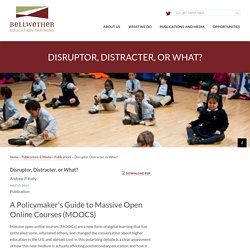
Lost in this polarizing debate is a clear assessment of how this new medium is actually affecting postsecondary education and how it could be used in the future. In this paper, Andrew P. Kelly clarifies the debate around the purpose and potential of MOOCs. Kelly argues that MOOCs are neither a panacea nor a passing fad, and instead, can serve as a tool for enhancing higher education and career training if properly deployed. Kelly highlights four early lessons learned in the first few years of innovation with MOOCs. MOOCs Expectations and Reality. The Pedagogies of e-Learning. NLC2004 /Proceedings / Individual Research Papers.
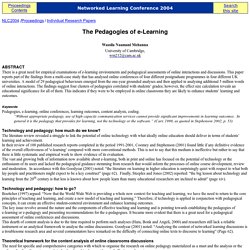
Pedagogy and e-Learning. Pedagogy and e-Learning e-Learning and collaborative/co-constructive pedagogies go together.The dynamics of classrooms change when e-Learning is part of the regular learning environment.Using collaborative, interactive pedagogies that also foster co-operation, appear to lead to effective learning and better teacher/student relationships over time.Technology in classrooms becomes an effective tool when teachers deliberately use them in relation to appropriate and targeted pedagogical practices.Preventing access in schools to mobile technologies or firewalling some sites does not teach effective and critical uses of these technologies that students have ready access to outside of school.Virtual worlds and gaming have potential in compulsory education.
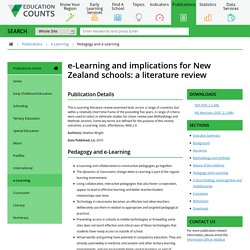
They are already used widely in medicine and aviation and other tertiary learning environments, and are increasingly being used in business as part of research and development, as well as employee induction. Students and e-Learning tools ( The Bartlett Future Pedagogy Conference 2014: MOOCs E-learning and Beyond. Rapid Power Tools: The top performers of eLearning authoring software. The eLearning authoring tool market has quietly been seeing a bit of a surge over the last couple of years—a surge that I have been thrilled to see.
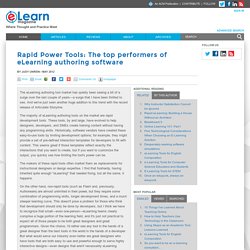
And we've just seen another huge addition to this trend with the recent release of Articulate Storyline. The majority of eLearning authoring tools on the market are rapid development tools. Top 10 e-Learning Experts To Follow in 2014. When was the last time you referred to an e-learning blog? Last week? Last month? And who do you follow? Regardless of your latest update, you are already outdated! No matter how bad your schedule looks, reading up on these whizz-musings is mandatory to your e-survival! Christopher Pappas Christopher Pappas maintains an active blog at e-Learning industry with a steady traffic from his Linkedin profile. Elearning subreddits curated by /u/niinakesamaa. Etusivu. MERLOT II - Home. Sharing Knowledge and Building Communities - OpenStax CNX.
eLearning, ePedagogy and Design - ACU (Australian Catholic University) This page contains resources developed by Australian Catholic University and other institutions and organisations on eLearning, ePedagogy and instructional design. eLearning is the transfer of skills and knowledge via Information and Communication Technologies (ICTs) which are often network-enabled (or supported). It encompasses a range of modes and platforms, such as web-based learning and computer-based learning, and a range of mediums, including the internet, learning management systems (LMS) like LEO, video and audio, and DVD. eLearning covers a broad continuum from fully online delivery to face-to-face learning, and can be self-paced or instructor-led. eLearning can encompass the use of a range of ICT tools that support learning theories such as reflective practices and social constructivism via such mediums as blogs (online journals), wikis, social networking, discussion forums, animations and podcasts.
Herrington, J., Kervin L (2007). Hu, C. (2007). 9 ways to reduce CL. 5 Ways to Reduce Cognitive Load in eLearning. The information processing capacity of learners is limited, so it's important that designers take this into account when creating eLearning courses. This article briefly discusses cognitive load theory and provides 5 ways to help reduce cognitive load that will help learners process information more effectively. In our brains, we have two types of memory. One is our working memory, which we use to process new information. The capacity of our working memory is quite limited so it can only handle so much before it becomes overloaded. The second is our long-term memory, which is where we store information from our working memory and where we retrieve that information from later.
Cognitive Load Theory (CLT) proposes that there are three types of cognitive load: Laatua e-oppimateriaaleihin. Pedagogiset käytännöt ovat aina oppimisen perusta, ei uusin ja innostavin teknologia. Monenlaiset digitaalisen teknologian välineet ja sovellukset ovat tulleet jäädäkseen, mutta niiden soveltaminen opetukseen on yhä vaikeaa. Laatua e-oppimateriaaleihin auttaa opettajia, kouluttajia ja muita oppimisen ja opetuksen parissa työskenteleviä soveltamaan erilaisia elektronisia aineistoja opetukseen. Salmon Five Stage Model of ELearning. E-oppimateriaalin laatukriteerit. Instructional Best Practices Using Technology. Pedagogy The following is a list of endorsed best practices that you may wish to explore and/or implement in your online course: Guidelines for Synchronous Assignments Organization: Instructional Design Well-designed course pages, rubrics, lessons, and assignments are paramount to superior design of online courses.
Instructional materials should be presented in a visual format appropriate to the online environment. Organization The definition of organize is to “form into a whole.” Guidelines for Synchronous Assignments. ARCS Design Process. The ARCS motivational design process is a systematic problem solving approach that requires knowledge of human motivation and progresses from learner analysis to solution design. More specifically, the process includes: Knowing and identifying the elements of human motivation, Analyzing audience characteristics to determine motivational requirements, Identifying characteristics of instructional materials and processes that stimulate motivation, Selecting appropriate motivational tactics, and Applying and evaluating appropriate tactics.
Thus, motivational design includes a systematic process that contains these steps and results in the preparation of learning environments that contain tactics, or activities, that have a predictable influence on the amount and direction of a person’s behavior. Motivation consists of the amount of effort a person is willing to exert in pursuit of a goal; hence, motivation has magnitude and direction.
Keller, J. Keller, J. Five Stage Model - Gilly Salmon. Writing. And speaking of height… Another wonderful example, more powerful as words than as an image: Jan Pen, a Dutch economist who died last year, came up with a striking way to picture inequality. Imagine people’s height being proportional to their income, so that someone with an average income is of average height. Sign In. WikIT. RUSE. Digitaaliset teknologiat tarjoavat uudenlaisia mahdollisuuksia opettaa, opiskella ja oppia.
Tieto- ja viestintätekniikan pedagoginen hyödyntämisellä voidaan parhaimmillaan edesauttaa oppijoiden erilaisuuden ja yksilöllisyyden huomioimista. Yksilöllistä tukea antava, kannustava ja lahjakkuuden eri muodot huomioiva opetus on nykyaikaa. Koulutussosiologian tutkimuskeskuksen RoSA-laboratorio tutkii ja kehittää digitaalisiin oppimisympäristöihin soveltuvia oppimista henkilökohtaistavia ratkaisuja. Suunnittelu- ja kehitystyössä huomioidaan laajasti elinikäisen oppimisen tukitarpeet oppimisratkaisuissa. Tutkimus- ja kehitystyössä hyödynnetään sekä perinteisiä tilastollisia menetelmiä että informaatioteknologian lähestymistapoja ja oppimisanalytiikkan tekniikoita.
Kaarakainen, M. Open Learning Initiative. Tietojärjestelmä on politiikkaa, osa 1: case opetuksen pilviväylä. Opetusministeriö suunnittelee ”pilviväylää” sähköisten oppimateriaalien välitykseen kouluihin. Hanke on sunnuntaihin asti kommentoitavana otakantaa-palvelussa. Understanding the lifelong journey of writing development. Elsevier Publishing Campus - Home. Kurssitarjonta. Tervetuloa kurssille! Verkkokurssin tuotantoprosessi (TIES463) on tietotekniikan aineenopettajien pakollinen syventävä opintojakso.
Opintojakson laajuus on 10 op.